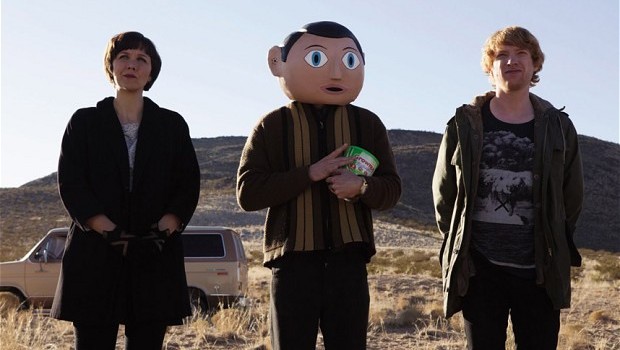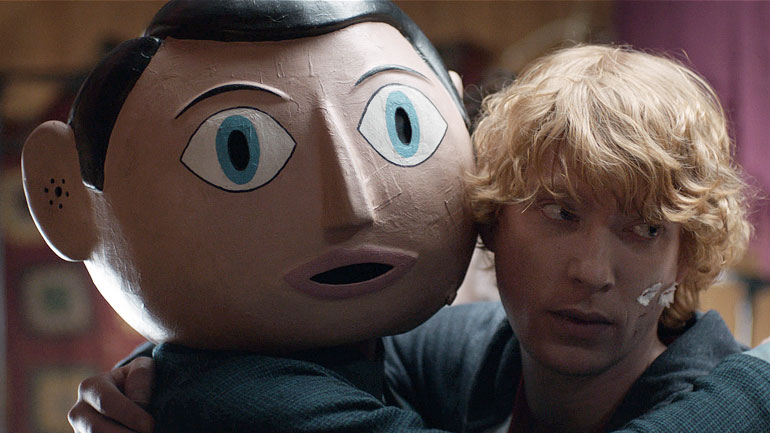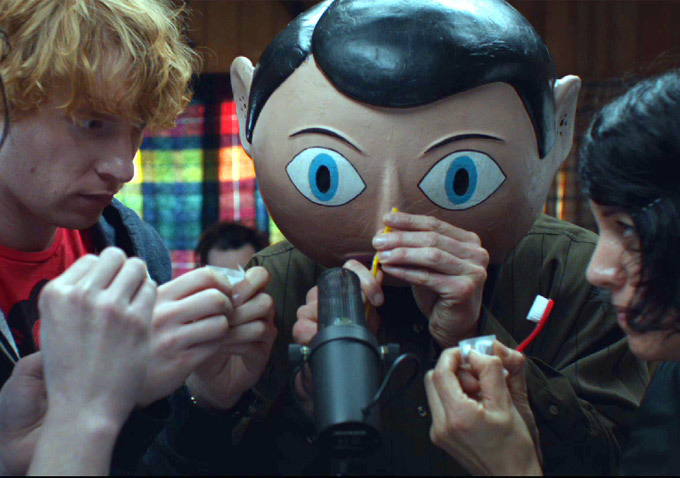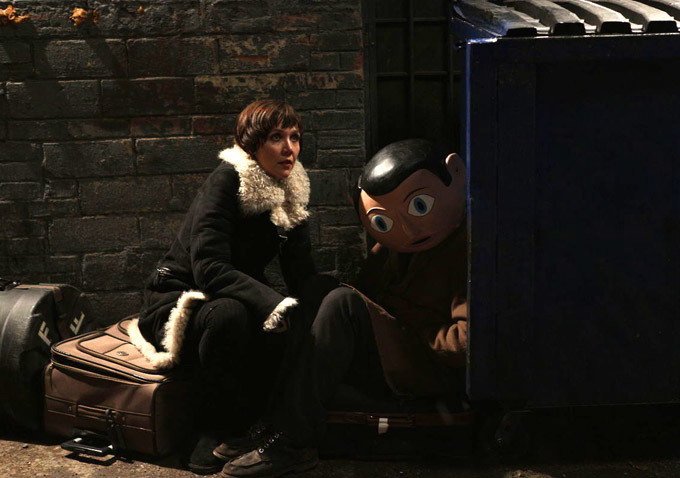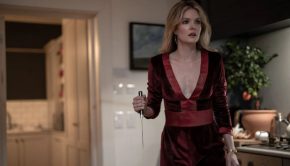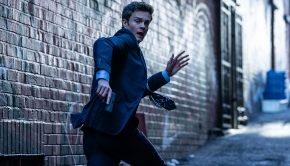Frank – Film Review
Reviewed by Damien Straker on June 18th, 2014
Madman presents a film by Lenny Abrahamson
Produced by: David Barron, Ed Guiney, Stevie Lee and Andrew Lowe
Written by Jon Ronson and Peter Straughan
Starring: Michael Fassbender, Domhnall Gleeson, Maggie Gyllenhaal, Scoot McNairy, Francois Civil and Carla Azar
Music by Stephen Rennicks
Cinematography: James Mather
Editing by Nathan Nugent
Running Time: 95 minutes
Rating: MA15+
Release Date: June 19th, 2014
Cinema locations:
Dendy Newtown, Palace Verona (NSW), Palace Electric (ACT), Cinema Nova, Palace Como (VIC), Palace Centro (QLD), Palace Nova Eastend (SA) and Luna Leederville (WA)
The film Frank and its title character both offer a weird exterior but beneath the quirkiness is a familiar arching goal and story structure dedicated to resolving a psychological crisis. It could be a criticism of the film that it buries its conventional resolutions and codas deep beneath the strange behaviour of its characters. Yet it is also using this conventionality to express the truth and desires about the character Frank (played by Michael Fassbender). Although Frank wears a giant head to hide his face from the world and even the members of his rock ‘n’ roll band, underneath is an unstable but real person whose most relatable aims are to reinvent himself and his identity to achieve total uniqueness. Directed by Lenny Abrahamson, from a screenplay by Tinker, Tailor, Soldier, Spy screenwriter Peter Straughan and Jon Ronson, Frank is at its best when it finds funny variations on parodying the difficulties of the creative process. An artist isn’t expressing their work to themselves but to other people. Is it more acceptable to be weird and unique, but detached from others, or generic and predictable? The way the film generates these questions after an initial viewing heightens its value and relevancy.
The film is loosely based on the experiences of its screenwriter Jon Ronson, who met the real life comedic character Frank Sidebottom. The Guardian posted an extract from Ronson’s book Frank: The True Story that Inspired the Movie. He describes how in 1987 he was asked to fill-in as a keyboard player for the punk band The Freshies, led by Chris Sievey. Frank was Sievey’s invention. On stage he would wear the giant papier-mache head and would only responded to being called Frank. The character wore a 1950s style suit and sang on stage with what Ronson called a “high-pitched nasal twang”. Frank’s story was that he still lived at home with his parents and his goal was to become a pop star. The character grew in popularity by covering popular songs and also by appearing on radio and television shows. In the extract, Ronson struggles to understand why Sievey kept the head on for so long and also the fluctuations in his weird and irrational behaviour. He likened Sievey to being transgender and trapped in the wrong body.
To protect Sievey from speculations about how obsessive he was about Frank, Ronson decided to fictionalise the film version. The differences in the real story and the film are sizeable. The film is set in the present day Britain, allowing for light references to social media like Youtube, Twitter and view counts. In the film Frank (Fassbender) has no alter ego. He is a mystery because he refuses to remove the head, even in the shower. This perspective of Frank is drawn from Jon (Domhnall Gleeson), a young man with a boring day job who is looking for inspiration for his music career. One day he is invited to play with Frank’s band “The Soronprfbs”. The band is compromised of Don the manager (Scott McNairy), who has his own fetishes, a Frenchman (Francois Civil), a female drummer (Carla Azar) and also Clara (Maggie Gyllenhaal) who intensely dislikes Jon for moving in on the group. After a failed gig, the band takes an unexpected detour to a lakeside cabin in Ireland where they attempt to compose an album using Frank’s unconventional methods of musical recordings and rehearsals.
One of the largest payoffs for Ronson and Straughan’s script is forwarding the narrative a year while the group is in the cabin. The time shift is unexpected and lends itself to the film’s thematic and comic structure: the friction between the band members as they sometimes hilariously fail to achieve artistic uniqueness. There is great variation in how the film draws humour from this second act. Slapstick is a strong device with Frank recording the sounds of his gumboots or a toothbrush or when Jon tries out a new method of shaving, which I thought was the film’s funniest moment. Characterising the band members with black, self-deprecating nudges is essential in preserving the comic energy too. The way Don hints about Frank’s unstable upbringing and his own quirks involving mannequins inspires some funny dialogue riffs on the way artists posture about having tragic upbringings and childhoods. There has never been a successful artist who wasn’t miserable. While Frank is treated like an awe-inspiring idol of mystery, some of the side characters like Clara are as obscure because we see few other sides to them when they could have been more rounded.
It is slightly disappointing that the laughs don’t carry into a shabby third act in America. Some of the disjointedness between the locations could be intentional to reflect Frank’s unease and nervousness but it still feels dislocated from the previous two acts. The film also sheds a lot of its comic wit in favour of a more sombre and serious tone that emerges almost out of nowhere followed by a simple and easy conclusion that seems formulaic in its message about speaking truthfully to find proper artistic rewards. It is odd that the film starts to edge towards those same painful upbringings that it initially parodied. Perhaps with more time with Frank the man instead of the image it might have been a more moving ending to the story. Yet since watching the film, Frank has grown on me because of the weight of the ideas about creativity and complacency. It also relishes an interesting cast who aren’t renowned for their comic traits. Sometimes the chances of being a little different or strange pay off and sometimes they don’t. It is the joy and the pain of any art form.
Summary: Since watching the film, Frank has grown on me because of the weight of the ideas about creativity and complacency.


